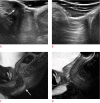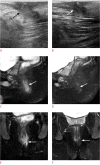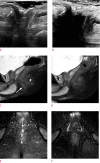Transperineal ultrasonography for treatment response evaluation in children with perianal Crohn's disease
- PMID: 36059211
- PMCID: PMC9532198
- DOI: 10.14366/usg.22057
Transperineal ultrasonography for treatment response evaluation in children with perianal Crohn's disease
Abstract
Purpose: This study assessed the performance of transperineal ultrasonography (TPUS) in evaluating the treatment response in children with perianal Crohn's disease (PACD) compared with pelvic magnetic resonance imaging (MRI).
Methods: This retrospective study was approved by the Institutional Review Board of our institution, which waived the requirement for informed consent. Twenty-nine patients (19 boys and 10 girls; median age, 14 years [range, 8 to 18 years]) with 56 fistulas were examined. Each fistula's thickness and abscess size were measured using both modalities, and treatment response was classified as positive or negative based on each modality. The concordance of the classifications was compared between TPUS and pelvic MRI. A receiver operating characteristic curve (ROC) was used to evaluate the performance of TPUS.
Results: TPUS found 80.4% (45/56) of the fistulas. On MRI, 39 fistulas (70%) were classified as having positive treatment responses, and the remaining 17 as having no response. The agreement of the classifications between TPUS and MRI was moderate (κ=0.486; P<0.001; Spearman ρ=0.573; P<0.001). Based on the ROC analysis with the MRI findings as a reference to distinguish positive from negative treatment responses, TPUS exhibited sensitivity, specificity, positive predictive value, negative predictive value, and accuracy of 63.3%, 93.3%, 95.0%, 56.0%, and 73.3%, respectively.
Conclusion: TPUS can be an appropriate adjuvant imaging modality for pelvic MRI to evaluate the treatment response of PACD in children when initial TPUS detects PACD with a location and imaging features comparable to those visualized on MRI.
Keywords: Abscess; Anal canal; Fistula; Ultrasonography.
Conflict of interest statement
No potential conflict of interest relevant to this article was reported.
Figures






Similar articles
-
Comparison of Transperianal Ultrasound With Colonoscopy and Magnetic Resonance Imaging in Perianal Crohn Disease.J Pediatr Gastroenterol Nutr. 2018 Apr;66(4):614-619. doi: 10.1097/MPG.0000000000001752. J Pediatr Gastroenterol Nutr. 2018. PMID: 28953535
-
Transperineal perineal ultrasound versus magnetic resonance imaging in the assessment of perianal Crohn's disease.Inflamm Bowel Dis. 2013 Dec;19(13):2737-43. doi: 10.1097/01.MIB.0000436274.95722.e5. Inflamm Bowel Dis. 2013. PMID: 24193154
-
Role of Transcutaneous Perianal Ultrasonography in Evaluation of Perianal Fistulae with MRI Correlation.Indian J Radiol Imaging. 2022 May 1;32(1):51-61. doi: 10.1055/s-0042-1743111. eCollection 2022 Mar. Indian J Radiol Imaging. 2022. PMID: 35722645 Free PMC article.
-
Transperineal ultrasound for assessment of fistulas and abscesses: a pictorial essay.J Ultrasound. 2019 Jun;22(2):241-249. doi: 10.1007/s40477-019-00381-6. Epub 2019 May 7. J Ultrasound. 2019. PMID: 31066004 Free PMC article. Review.
-
New horizons in the imaging of perianal Crohn's disease: transperineal ultrasonography.Expert Rev Gastroenterol Hepatol. 2017 Jun;11(6):523-530. doi: 10.1080/17474124.2017.1309285. Epub 2017 Mar 28. Expert Rev Gastroenterol Hepatol. 2017. PMID: 28319427 Review.
Cited by
-
Assessment of long-term outcomes following Milligan-Morgan hemorrhoidectomy with Doppler transperineal ultrasound and endoscopy: a pilot study.Int J Colorectal Dis. 2025 May 1;40(1):104. doi: 10.1007/s00384-025-04894-x. Int J Colorectal Dis. 2025. PMID: 40310510 Free PMC article.
-
Novelties and Perspectives of Intestinal Ultrasound in the Personalised Management of Patients with Inflammatory Bowel Diseases-A Systematic Review.Diagnostics (Basel). 2024 Apr 12;14(8):812. doi: 10.3390/diagnostics14080812. Diagnostics (Basel). 2024. PMID: 38667458 Free PMC article. Review.
-
Perianal Fistula; from Etiology to Treatment - A Review.Middle East J Dig Dis. 2024 Apr;16(2):76-85. doi: 10.34172/mejdd.2024.373. Epub 2024 Apr 30. Middle East J Dig Dis. 2024. PMID: 39131109 Free PMC article. Review.
References
-
- de Zoeten EF, Pasternak BA, Mattei P, Kramer RE, Kader HA. Diagnosis and treatment of perianal Crohn disease: NASPGHAN clinical report and consensus statement. J Pediatr Gastroenterol Nutr. 2013;57:401–412. - PubMed
-
- Schwartz DA, Loftus EV Jr, Tremaine WJ, Panaccione R, Harmsen WS, Zinsmeister AR, et al. The natural history of fistulizing Crohn's disease in Olmsted County, Minnesota. Gastroenterology. 2002;122:875–880. - PubMed
-
- Singer AA, Gadepalli SK, Eder SJ, Adler J. Fistulizing Crohn's disease presenting after surgery on a perianal lesion. Pediatrics. 2016;137:e20152878. - PubMed
-
- Keljo DJ, Markowitz J, Langton C, Lerer T, Bousvaros A, Carvalho R, et al. Course and treatment of perianal disease in children newly diagnosed with Crohn's disease. Inflamm Bowel Dis. 2009;15:383–387. - PubMed
-
- Vernier-Massouille G, Balde M, Salleron J, Turck D, Dupas JL, Mouterde O, et al. Natural history of pediatric Crohn's disease: a population-based cohort study. Gastroenterology. 2008;135:1106–1113. - PubMed
Grants and funding
LinkOut - more resources
Full Text Sources

